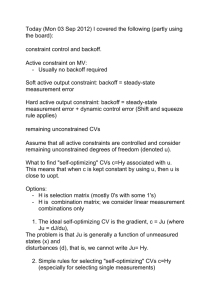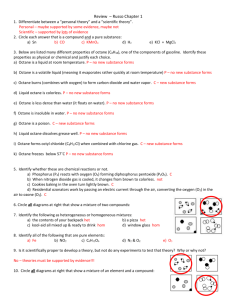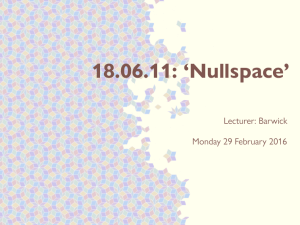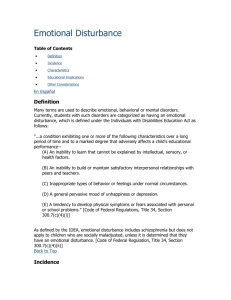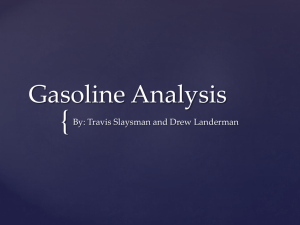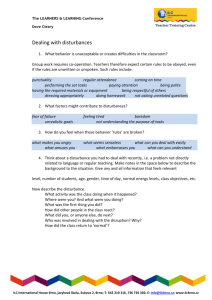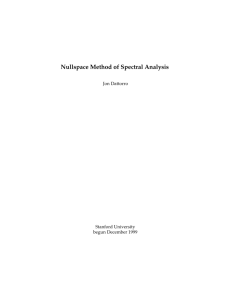Exercise 1 in Advance posses control (SIK20AH)
advertisement
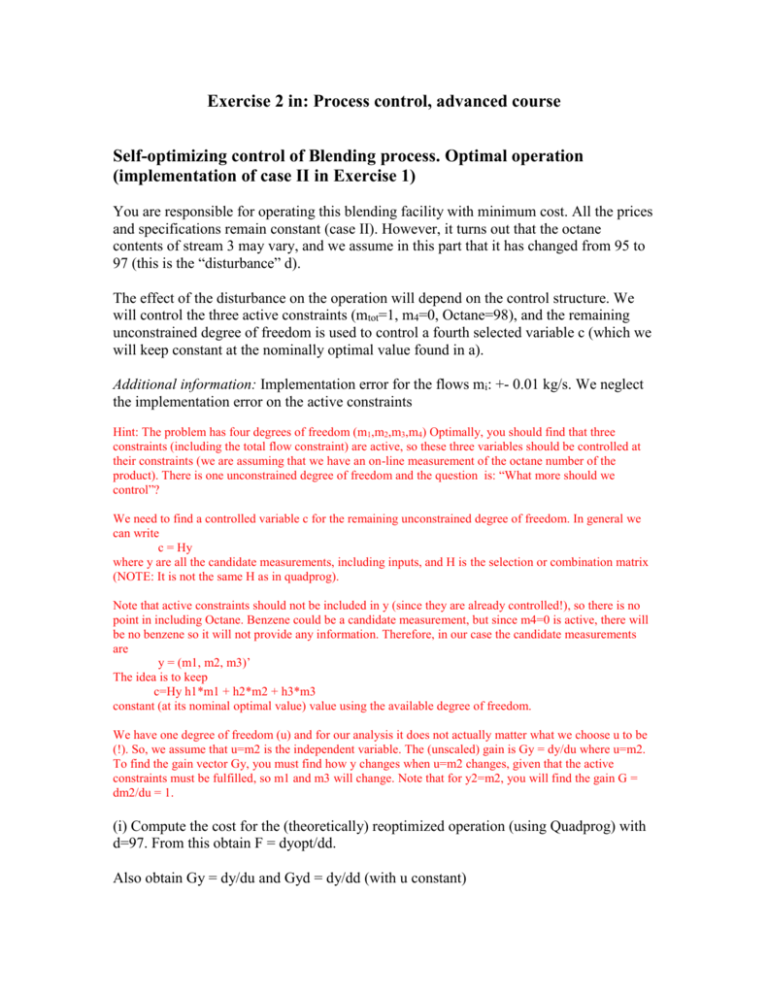
Exercise 2 in: Process control, advanced course Self-optimizing control of Blending process. Optimal operation (implementation of case II in Exercise 1) You are responsible for operating this blending facility with minimum cost. All the prices and specifications remain constant (case II). However, it turns out that the octane contents of stream 3 may vary, and we assume in this part that it has changed from 95 to 97 (this is the “disturbance” d). The effect of the disturbance on the operation will depend on the control structure. We will control the three active constraints (mtot=1, m4=0, Octane=98), and the remaining unconstrained degree of freedom is used to control a fourth selected variable c (which we will keep constant at the nominally optimal value found in a). Additional information: Implementation error for the flows mi: +- 0.01 kg/s. We neglect the implementation error on the active constraints Hint: The problem has four degrees of freedom (m1,m2,m3,m4) Optimally, you should find that three constraints (including the total flow constraint) are active, so these three variables should be controlled at their constraints (we are assuming that we have an on-line measurement of the octane number of the product). There is one unconstrained degree of freedom and the question is: “What more should we control”? We need to find a controlled variable c for the remaining unconstrained degree of freedom. In general we can write c = Hy where y are all the candidate measurements, including inputs, and H is the selection or combination matrix (NOTE: It is not the same H as in quadprog). Note that active constraints should not be included in y (since they are already controlled!), so there is no point in including Octane. Benzene could be a candidate measurement, but since m4=0 is active, there will be no benzene so it will not provide any information. Therefore, in our case the candidate measurements are y = (m1, m2, m3)’ The idea is to keep c=Hy h1*m1 + h2*m2 + h3*m3 constant (at its nominal optimal value) value using the available degree of freedom. We have one degree of freedom (u) and for our analysis it does not actually matter what we choose u to be (!). So, we assume that u=m2 is the independent variable. The (unscaled) gain is Gy = dy/du where u=m2. To find the gain vector Gy, you must find how y changes when u=m2 changes, given that the active constraints must be fulfilled, so m1 and m3 will change. Note that for y2=m2, you will find the gain G = dm2/du = 1. (i) Compute the cost for the (theoretically) reoptimized operation (using Quadprog) with d=97. From this obtain F = dyopt/dd. Also obtain Gy = dy/du and Gyd = dy/dd (with u constant) (ii) Consider the following alternative choices for the fourth controlled variable c: The most obvious choice is to keep one of the flows constant: 1. m1 = constant; corresponds to H = (1 0 0), that is, c=1*m1+0*m2+0*m3 = m1 2. m2 = constant 3. m3 = constant Finally, find the optimal linear combination and the “exact local method”: 4. Optimal combination of m1 and m2 (H) according to the nullspace method (with zero disturbance loss) 5. Optimal combination of m1 and m2 (H) according to the exact local method (use analytic expression, see below) 6. Optimal combination of m1, m2 and m3 (H) according to the exact local method (use analytic expression) 7. m2 and m3 (NOT REQUIRED) 8. m1 and m2 (NOT REQUIRED) 9. m3 and m4 (NOT REQUIRED, since m4=0 it would be the same as controlling m3) NOT REQUIRED: We may also try keeping ratios or other combinations of variables constant 10. m1/m2= constant Comment on Nullspace method: Make a change (should preferably be small to stay in the linear range) in the disturbance and reoptimize. This will give new values for m1, m2, m3, m4 etc. From this, find the sensitivity matrix F = dyopt/dd = (dm1opt/dd dm2opt/dd dm3opt/dd)’ = (f1 f2 f3) The nullspace method is to select the “combination matrix” H =(h1 h2 h3) such that HF = 0 h1*f1 + h2*f2 + h3*f3 =0 This gives one equation with three unknowns (h1, h2, h3), but only the ratio between the h’s matter so we may as well divide the equation by h1 (provided y1=m1 is actually included in the combination) to get one equation in two unknowns f1 + (h2/h1)*f2 + (h3/h1)*f3 = 0 This has infinitely many solutions, so to simplify we can get zero disturbance loss with two variables, for example m1 and m2, m1 and m3, or m2 and m3. The nullspace method does not consider noise, and to minimize the effect of noise one should avoid measurements (y = (m1 m2 m3)) with a small gain. You will find that this means that m1 should be included, whereas m2 and m3 are almost the same. For case 5, we get h3=0 and the nullspace method gives the following combination f1 + (h2/h1)*f2 = 0 or c = Hy = 1*m1 + (h2/h1)*m2 and your task is to find (h2/h1). Comment: This agrees with the theory that you need to combine at least nu+nd measurements to get dcopt=0 and in our case nu=1 and nd=1, so we need 2 measurements. Comment on exact local method. Want to find H that minimizes the Frobenius norm of Juu1/2 (HGy)-1 HY where Y = [F Wd Wny]. The optimal H can be found from the following analytical expression: 1/ 2 HT (YY T ) 1 G y (G yT (YY T ) 1 G y ) 1 J uu Actually, we do not need the last square parts (which are scalars in our case with only 1 degree of freedom) when finding the H for a given measurement set, so can compute the optimal H from HT (YY T ) 1 G y (you can afterwards scale H such that, for example, h1=1) (iii) What is the rank of the six choices according to the “brute-force evaluation”Compute the loss with d=97 and the worst-case implementation error for the alternative choices. Hint: Outline of “brute-force” solution for choice 1: The optimal value from a) is to have m1=0.26 so we will keep it constant at this value. Furthermore, we are keeping the following constant (at their constraints) m4=0 m1*99 + m2*105 + m3*97 + m4*99 = 98 m1 + m2 + m3 + m4 = 1 (Note that the control system keeps the product octane number constant at 98 in spite of the change in octane number for stream 3 has changed from 95 to 97). Solving these equations give m4=0, m2=0.06, m3=0.68, m1=0.26 and the corresponding cost is J = 0.26*0.126 + 0.06*0.12 + 0.68*0.2 + 0*0.185 = 0.12636 To get the worst-case cost with implementation error, you need to find J with m1=0.27 and m1=0.25 kg/s, and take the highest J. NOTE THAT THE ACTUAL IMPLEMENTATION (“pairing”) OF THE CONTROL SYSTEM DOES NOT MATTER FOR THIS ECONOMIC LOSS ANALYSIS. (iv) Would your results change if we included the implementation error on the active constraints? Changes in active constraints, for example due to implementation error or changes in their setpoints, has the effect of a disturbance on the remaining problem. So it will change the results. With the nullspace method, one could in theory get zero effect for a given active constraint error by including it as a second disturbance, but then one would need to combine all three measurements, c =h1*m1 + h2*m2 + h3*m3. F would then be a matrix with two rows and we would need to solve two equations to find (h2/h1) and (h3/h1).

